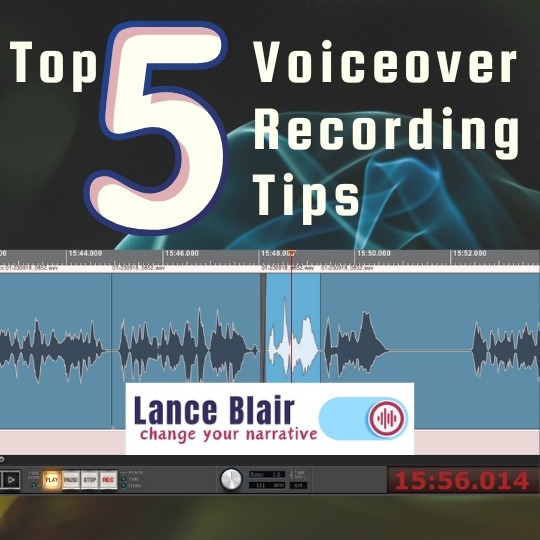5 Tips for Great Voice Over Recordings
How do you get that professional finished sound for voice overs from your home or remote studio? You don’t need to spend a lot of money on gear, if you start with no weak links in your audio chain. And you don’t need to have the best gear if you use it correctly. A great microphone with the wrong placement and acoustics won’t sound great. But an adequate microphone with smart placement, good acoustics, and proper levels will sound great! Here are the Top 5 Voiceover Recording Tips:
Start with a Good Room and Good Gear
- Have a great sounding room. Make sure your recording area is quiet, with a noise floor of at least -60 dBFS RMS when recording with peaks between -12 and -6 dBFS. The room should have acoustic treatment with DIY or professionally built acoustic panels and bass traps. Some foam and absorbent blankets can help. Note that foam panels do little to tame lower frequencies. The goal is to lessen reverberation and any overstated low frequencies that create a tubby or muddy sound. Also watch out for close sound reflections that can come from a large desk area or a metal script stand. It’s a good idea to cover these with carpet samples or blankets. When I record close to a computer screen, I tilt it slightly away from me, so the sound isn’t reflecting straight back.
- Have a quality microphone. While studios may ask specifically for a U87, TLM-103, or MKH 416, you don’t have to own one to get a great sound these days and there are many that sound very close to the originals. There are so many manufacturers now making great microphones for voiceover with their own sound, too! Look for a mic that has a consistent frequency response curve and low self-noise. Below 14 dB-A is ideal, and 18 dB-A is at the upper-end of acceptable. Consider the pick-up pattern. A tight-patterned cardioid mic is good for recording voice, but if it’s too tight it’s harder to stay on axis for voice acting. Depending on the voice resonance, over-sling or under-sling placement may be preferred. A distance of 6 to 12 inches from the microphone is standard. However, it depends on the microphone and how much Proximity Effect is wanted. Proximity Effect is increased bass response that usually comes into play when coming closer than 6 inches from most cardioid (directional) microphones. Experiment with various microphone placements in your recording environment, and be open to working with more than one solution for different styles of voice over read.
- Have a quality microphone preamp Again, like most of the Top 5 Voiceover Recording Tips, this doesn’t require the best gear. It’s how you use it. There are many affordable audio interfaces that come with quality microphone preamps. The latest offerings from Focusrite, MOTU, SSL, and UA are all recommended. On the other hand, I’ve heard plenty of voice overs done with $2000-$3000 external preamps that, well, didn’t sound all that great because the room and/or microphone placement was not optimal. When using an outboard/external preamp other than, or in addition to, the preamps built into your audio interface, there are two main things to watch for. First, a preamp with a pronounced tube or transistor-based harmonic distortion might sound lovely, but studios want audio files that are as clean as possible. Studios like to add their own special “flavors” to voice overs in post to suit their mix. Second, a High Pass Filter (HPF) on a preamp set to 100 Hz or higher can be too high, especially for male voices. HPFs set to 80 Hz or lower are preferred. I’ve even seen studios asking that HPFs not be set higher than 70 Hz or 80 Hz.
- Gain Staging. If you’re using an such an outboard microphone preamp, set your gain there, and then send it line-in to your audio interface. Important: make sure the gain on the interface is as low as possible. When you are running two higher sets of gain it’s a case of ‘too many cooks spoils the broth’. The sound will be veiled and muddy. For example, your Audio Interface line input could be set at 20% gain, while your external preamp could be at 35 dB input gain and 50% output gain. That could work nicely. But, you wouldn’t want 50% Audio Interface gain, 50 dB external preamp input gain, and 10% output gain. Then you’re just driving everything too hard and introducing distortion just to get a usable level.
Another thing to note is that you should set your recording levels to be between -20 dBFS and -12 dbFS on your DAW recording software. “dbFS” means “Decibels Relative to Full Scale” which is the decibel wave amplitude measurement in digital systems. -20 dBFS is the digital equivalent of the good old “0” in VU analogue recording. Don’t record things too hot. Peaks of -9 dbFS are tolerable when recording. Still, keep it cool, and then turn up the volume heat after you record. For further explanation about recording levels for DAWs, check out this good article from Sound on Sound. In many ways, Gain Staging is arguably the most important of the Top 5 Voiceover Recording Tips!
- Record at 48 kHz /24 bit. Okay, okay…I know 44 kHz / 16 bit is all that is needed for excellent sound for the range of human hearing. However, if you or the studio you are working with are going to process the audio for post production, the effects will work a bit better with the higher rates. Then, you can down convert however you’d like for the final mixed-down voice over.
Setting Voiceover Levels
Good luck, and I hope you found these Top 5 Voiceover Recording Tips helpful. Let me know in the comments what other tips and advice you have to share with others. Thanks!

